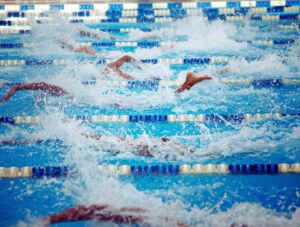Sports doping and antidoping – a brief history

Doping and antidoping in sports are often mentioned in the same breath, but their histories are very different. While athletes have taken performance enhancing drugs – mostly legally - for over 2,000 years, antidoping regulation and scientific methods for catching drug cheats only picked up speed late in the late 20th century. In this article, we examine the long, dangerous, and often political history of performance enhancing substances - and how growing ethical and health concerns eventually led to the development of antidoping testing science and medicine, supervised by the World Anti Doping Agency.
Introduction
The word 'doping' is thought to derive from the Dutch word ‘doop', meaning a viscous opium juice. An early definition proposed by the Council of Europe was “the administration, by any means... of a substance foreign to the body or of abnormal quantities of physiological substances, with the sole aim of artificially and unfairly enhancing individual performance in a competition.” Although athletes have been doping for as long as organised sports have existed, it appears that nobody tried to prevent it for more than 2,000 years – until 1928, when the International Amateur Athletic Federation (IAAF) first outlawed the practice.
Today, most sports governing bodies around the world support antidoping on ethical and medical grounds. Their reasoning is that, “Since sport plays an important role in physical and mental education and in promoting international understanding and cooperation, the widespread use of doping products and methods has consequences not only on health of the athletes, but also upon the image of sport.”
But conversely, with modern sport evolving into a multi-billion dollar industry, and a prime-time, cultural spectacle beamed into billions of homes, there are now more reasons to dope than ever before. Vlad et al. argue that “Nowadays, sports are no longer just sports (and) as sport become(s) an industry, a business, a reason for political or national pride, these facts can only lead to breaking any rules to win.” Now that “sports mean sponsors, advertising contracts and money .... some believe that any risk is worth taking. Even risks to their own health.”
What this means for those trying to ensure a level playing field is that “The doping phenomenon in sports is increasing and diversifying, as are the drugs used for doping.” While, in earlier years, individuals or small groups of athletes took fairly primitive performance-enhancing substances or mixtures, today’s doping programmes are often meticulously planned and state sponsored, and encompass an ever-growing array of drugs and methods. This has led to “a permanent race among those who invent new doping methods and sports ethics organizations that are searching for more performant methods to detect them. Unfortunately, most of the time, those in the first category are always one step ahead.”
Two-and-a-half millennia of legal doping
The Olympic games held between 776BC and 394AD in ancient Greece had a zero tolerance approach to cheating. Not only would competitors found guilty of doing so be banned for life, but their names and misdemeanours would be recorded on stone pedestals at the entrance to the stadium in Olympia, where they also served as a warning to athletes about to compete. But while breaking the rules – for example, by bribing an opponent to underperform – “was dealt with harshly, it does not appear that the use of drugs and other substances to improve athletic performance was considered cheating.” Nor, Yesalis and Barkhe state, “does it appear that any culture in early history made any effort to discourage the use of ergogenic substances.” Thus, ancient Greek athletes consumed animal hearts and testicles, as well as brandy and wine concoctions and hallucinogenic mushrooms to improve performance. Meanwhile, at the Coliseum in Rome, gladiators used hallucinogens and stimulants, such as strychnine, “to stave off fatigue and injury and to improve the intensity of their fights.” But the use of what would today be regarded as prohibited drugs seems to have been “absolutely normal” to the ancients, with “those who offered such substances being considered medical specialists in sports.”
Remarkably, we need to zip forward another 1,600 or so years to find the next big thing in sports doping. Rapid developments in medicine in the late 19th century also led to “a significant growth in the use of drugs and other substances to improve performance”, with “the primary emphasis ... on stimulants as ergogenic aids”. For example, a mixture of coca leaf extract and wine called Vin Mariani was widely used by French cyclists, and the 1904 Olympic marathon champion, Thomas Hicks, won with the help of two – then legal – doses of strychnine. In this period, “Mixtures of strychnine, heroin, cocaine, and caffeine were used widely by athletes and each coach or team developed its own unique secret formulae” – something that “was viewed as a standard practice, out in the open... “(while) not until the 1920s was there any widespread attempt to admonish doping in sport, much less designate it as a formal violation of rules or as cheating.”
State sponsored doping
After the reunification of Germany in 1990, a “treasure trove” of documents held by the former East German secret police revealed what many had long suspected – “East Germany had conducted a state-sponsored, systematic doping operation that led to spectacular sporting success.” As a recent article by BBC Sport’s Olivier Guiberteau recalls, the many Western observers who harboured suspicions about state sponsored doping behind the Iron Curtain had been proven right: “Here was confirmation the other side had been cheating all along.”
But, as Guiberteau adds, the narrative about the East being “dirty” and the West being “clean” was “not as well-defined as the line that had cut Germany in half for nearly 50 years.” He quotes Letizia Paoli, the chair of the 2009 committee investigating historic West German doping activity at the University of Freiburg, who says that when East German athletes started being successful, “West German politicians started worrying about it and spreading the message that West German athletes needed to win medals too.”
Heptathlete Birgit Dressel was one many athletes in West Germany’s clandestine doping programme, which centred around a group of medics at Freiburg, including sports physician Armin Klumper. Like a number of others, Dressel received so-called “Klumper cocktails” – performance enhancing mixtures of off-label and prescription medicines, doping products and natural remedies. Tragically, the 26-year-old died in agony in April 1987, from allergic-toxic shock and rapid organ failure after taking medication to help her with a bad back. “Her autopsy revealed traces of more than 100 drugs in her system,” Guiberteau writes, “including anabolic steroids that she had been taking for years.”
But the end of the Cold War did not mean the end of state sponsored doping. In 2016, the World Anti Doping Agency (WADA) released the results of an independent investigation that found Russia’s Ministry of Sport “orchestrated systematic cheating of Russian athletes to subvert the doping control process”- notably at the 2014 Winter Olympics and Paralympics in Sochi, southern Russia, where samples within the games’ WADA-accredited laboratory were tampered with. Since the cheating also involved 20 summer sports, WADA argued that “the presumption of innocence of athletes in these sports, and in all Russian sports, is seriously called into question”, and called successfully for Russia to be refused entry to the 2016 Olympic and Paralympic games.
LGC – for all your antidoping testing needs
Toxicological analysis for sports related drugs and steroids plays a vital role in doping controls that attempt to ensure fair play, as well as highlighting potential health risks associated with their misuse.
LGC Standards offers more than 800 reference materials and research chemicals for sports drugs and steroid testing - including metabolites, matrix materials and SILs - to support the fight against doping, as well as to help your laboratory conform with technical requirements set by WADA and national antidoping organisations around the world.
LGC ASSURE meanwhile provides state-of-the-art supplement analysis, banned substance testing, and research services to a broad range of customers working in human and animal sports.
|
The antidoping response
While events at Sochi provide sobering support for the argument that drug cheats “are always one step ahead” of the authorities, it can also be argued that some of antidoping’s biggest steps forward have come in the wake of major drug scandals.
Widely used during World War Two to minimise fatigue in combat conditions, amphetamines became common in sports from the late 1950s (and were known as “la bomba” amongst impressed Italian cyclists). But the deaths of two riders with amphetamine in their systems – Denmark’s Knud Enemark Jensen at the 1960 Olympics, and Briton Tom Simpson during the 1967 Tour de France – finally prompted some meaningful action from sports authorities. “The impact of Simpson's death was extensive,” Yesalis and Barkhe write, “in part because 'this was the first doping death to be televised”. Combined with Jensen’s demise, it put pressure on the International Olympic Committee (IOC) to establish doping control programs, which it did in 1967.
Although the IOC reforms introduced drug testing for the first time, as well as formally banning many performance enhancing substances, Fisher describes its initial antidoping programmes as “neither systematic nor robust, lacking both methodologically and technologically.” However, he adds that “the gap between doping and monitoring gradually began to close as testing became more accurate and reliable”, notably when the first reliable testing procedure for anabolic steroids was developed in 1976. Eventually, these scientific advances would net the antidoping authorities their biggest catch yet: the Canadian Sprinter Ben Johnson, who was disqualified for a positive steroid test after winning the 100 metres at the 1988 Olympics.
A decade later, another major cycling scandal led directly to the formation of WADA - perhaps the most significant antidoping step yet taken. The 1998 Tour de Francehad featured riders, doctors and other team staff in a shocking, almost daily series of drug-related arrests, illicit drug seizures, team expulsions and criminal prosecutions. It also later transpired, after retrospective testing, that 33 riders – including the top three finishers – had been taking erythropoietin (EPO), a prohibited hormone that boosts performance by increasing red blood cell production. Following the race, the IOC convened the First World Conference on Doping in Sport – setting in train the establishment of the world’s first independent international antidoping agency. Created in November 1999, “to protect athletes, promote the values of clean sport, and preserve the spirit of sport internationally”, WADA now enjoys “nearly unanimous support from nations worldwide”, and promulgates the World Anti-Doping Code - combining “a severe punishment regime, frequent mandatory testing, and a comprehensive list of banned substances that is updated annually.”
Challenges and methods in antidoping testing
WADA also supports the development of antidoping testing science and medicine, in order to ensure that its code and related international standards can be implemented effectively. Its "banned list" includes more than 200 substances (ranging from anabolic agents, Beta 2 agonists, CNS stimulants, and corticosteroids to diuretics, masking agents and growth hormones) and three forbidden methods (enhancement of oxygen transfer, physical and chemical manipulation, and gene doping). This broad range of possible doping options makes laboratory testing for performance enhancing substances a hugely complex process - even before factoring in the almost constant development of new drugs, and ways to conceal them (such as micro-dosing, using masking agents, or timing substance use). The two-step analytical strategy necessary to fulfil WADA requirements firstly involves a rapid screening test in order to indicate the presence or absence of a doping agent and, in most cases, the presence of a banned substance in the matrix is enough to constitute a violation of antidoping rules. However, the presence of a few substances – such as salbutamol, morphine, ephedrine, and carboxy-tetrahydrocannabinol - will also require quantitative analysis, since they only become problematic at certain threshold concentrations.
High levels of endogenous substances also need quantification in order to estimate a potential adverse analytical finding, while neither gas chromatography nor liquid chromatography coupled with tandem mass spectrometry are able to differentiate between endogenous and exogenous sources. As Badoud et. al have pointed out, this has led to various additional strategies – including statistical threshold levels or ratios for urinary norandrosterone and testosterone, and the introduction of isotope ratio mass spectrometry (IRMS), based on enrichment of 13C, to distinguish between endogenous and synthetic steroid analogues. Meanwhile, an athlete’s biological passport can be helpful in accounting for intra-individual variation of indirect markers, thus revealing changes in biological parameters (e.g. haemoglobin, haematocrit, ferritin) caused by taking a banned substance such as EPO.
Get more from LGC Standards



